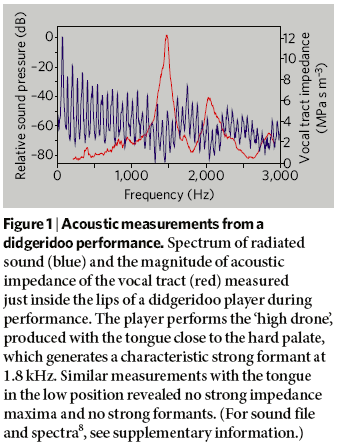|
News & Views item - July 2005 |
![]()
Australian Physicists Go Interdisciplinary to Reveal the Secrets of Didgeridoo Virtuosity. (July 7, 2007)
 |
Alex Tarnopolsky*, Neville Fletcher*†, Lloyd Hollenberg‡,
Benjamin Lange*, John Smith* and JoeWolfe* From the *School of Physics,
University of New South
Wales, †Research School of Physical Sciences, Australian National University and
‡School of Physics, University of Melbourne have made acoustic measurements
showing how a player can extract a range of timbres from this primitive
instrument and published their findings as a Brief Communication in the July 7,
2005 issue of Nature.
The authors open with with the assessment that:
The Australian didgeridoo (or yidaki in the Yolngu language of northern Australia) is a simple musical instrument that, at the lips of an experienced player, is capable of a spectacular variety of timbres — considerably greater than those that can be coaxed from orchestral instruments, for example.
And then proceed to analyse why. They "simultaneously measured the sound produced by the didgeridoo and the acoustic impedance of the player’s vocal tract". See the accompanying figure taken from the Nature Brief Communication.
According to Tecumseh Fitch, a bioacoustics expert at the University of St. Andrews, Scotland, the "didgeridoo is a unique hybrid between the human voice and a musical instrument". The vocal tract and didgeridoo forming one big tube, controlled by the vocal tract. So, It can produce a huge variety of different timbres, despite that usually only a single note is produced by the player, but because a virtuoso can skilfully modify the acoustics inside his mouth, he can produce a variety of strong resonances at different frequencies.
As Joe Wolf put it, "It's easy to make a basic sound. But learning these strong formants takes a while." To linguists a "formant" is "any of several frequency regions of relatively greater intensity in a sound spectrum, which together determine the characteristic quality of a vowel sound."
The note of the didgeridoo can be considered analogous to that produced by the
drone pipe of the bag pipe, but the variations in sound heard by the listener
are produced by the player vocalising while playing but as well is able to
silently alter the shape of the glottis which, according to the authors, is done
subconsciously. And if you're thinking of taking up the instrument you must
first become proficient in circular breathing.
The authors have made available a considerable amount of supplementary material1, 2 on the web including sound files.
[Note: If clicking on the links gives an error message, click the "back" button and then retry.]